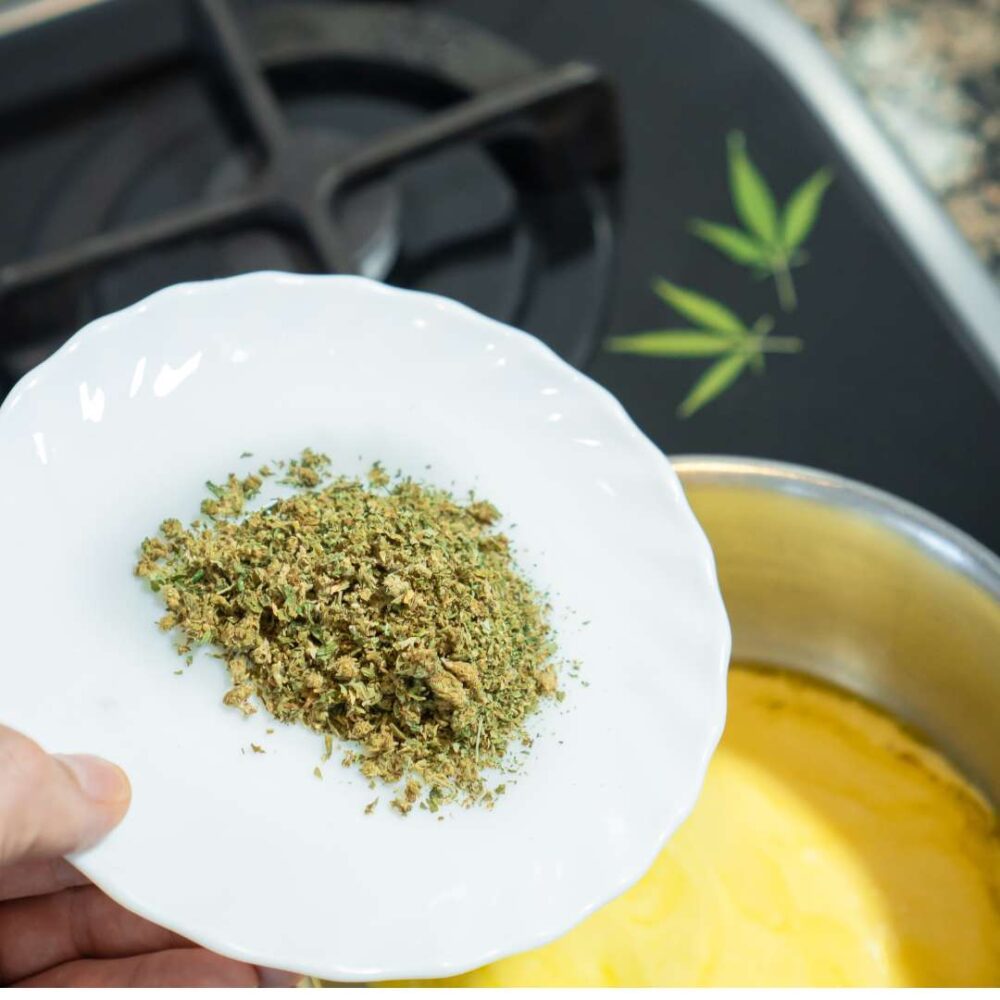
Many cannabis growers and users usually discard the plant's leaves and stems, called cannabis trim, in the growing process. But did you know that they contain even a small amount of cannabinoids that still can be beneficial? Cannabis trim is often thought to be a waste, but it can be repurposed into something useful.
By transforming the trimmings into cannabutter, you can create a versatile ingredient. It can be used for both medicinal and recreational purposes. In fact, cannabutter, also called weed butter, is a must-have for any hemp or marijuana plant enthusiast.
This article will provide you with a comprehensive guide to making your own cannabutter from cannabis trim. Keep reading to learn more and start enjoying the benefits of this versatile ingredient.
Article Highlight
- Cannabis trim, composed of sugar leaves and fan leaves, refers to the leftover plant material that remains after cannabis plants have been harvested.
- They can still be used for making cannabis edibles or other infused products, particularly cannabutter.
- Cannabutter is a short and popular term for cannabis butter that is made by infusing butter with cannabis flower, high-quality buds, or trimmings from hemp or marijuana plants.
- Cannabis butter makes a versatile ingredient in various dishes and edibles so you get all the health benefits of THC or CBD in your meal.
What is Cannabis Trim?
Cannabis trim refers to the leftover plant material that remains after cannabis plants have been harvested. The trim leaves are composed of small sugar leaves and larger fan leaves that have been removed from the cannabis flowers and buds. While many people may dismiss trim as waste, it actually contains a small amount of cannabinoids that's still beneficial.The tiny sugar leaves that make up a portion of cannabis trim can contain between five and seven percent cannabinoids. It includes THC, CBD, and the minor cannabinoids. This makes them a valuable source of plant material for making extracts, such as bubble hash or cannabis oil.
Larger fan leaves, on the other hand, contain a lower concentration of cannabinoids, typically ranging from two to three percent. However, they can still be used for making cannabis edibles or other infused products, particularly cannabutter. These plant materials contain other beneficial compounds like terpenes and flavonoids.
What is Cannabutter?
Cannabutter is a short and popular term for cannabis butter. Cannabis butter is a delicious and versatile ingredient made by infusing butter with cannabis flower, bud, or fresh trim from a cannabis plant. It can be used as an ingredient in various cannabis-infused recipes, such as in making pot brownies and many other homemade edibles.The potency of cannabis butter will depend on a couple main items:
- The strength (potency) of the particular strain of cannabis used.
- The amount of weed trimmings or marijuana trim added to the butter
- The amount of butter used in proportion to the trim leaves
- How well the extraction is performed
Preparation for making cannabutter
Are you ready to make your own batch of homemade cannabutter from trim? Here are the essential ingredients and equipment you'll need to get started:- A large pot or saucepan to hold all your marijuana trimmings. Make sure that the saucepan is nonstick to the cannabutter from burning onto your pan during the cooking process.
- A fine-weave cheesecloth which you can easily find at any grocery or kitchen supply store. It will help you extract the oils from your weed trim and mix them with regular butter for a smooth, balanced taste.
- Unsalted regular butter that is carefully chosen to ensure it won't affect the flavor of the final product. You can also use clarified butter in making weed butter or other types of full-fat butter, such as coconut oil or olive oil. Make sure to avoid salted butter, as the salt can impact the taste of your cannabutter.
- Cannabis trim, which is composed of weed leaves particularly fan leaves and sugar leaves that are left over from the manicuring process. These are the main ingredients used in making cannabis butter.
- Water as an essential medium for extracting the cannabinoids from your marijuana trimmings.
- Airtight containers to mix and store the weed butter for up to a week without worrying about spoilage or mold.
Decarboxylation
Decarboxylation is a process that removes a carboxyl group of precursor compounds, converting CBDA into CBD and THCA into THC. Here are step-by-step instructions on how have a decarbed cannabis:- Preheat your oven in medium heat about 240°F (115°C). Line a baking sheet with parchment paper or aluminum foil, whichever is available.
- Grind your cannabis trim into small pieces, but not too finely. You can use a hand grinder or a food processor to do this.
- Spread the cannabis evenly on the parchment-lined baking sheet. Be sure not to pack it too tightly as it may not heat evenly.
- Place the baking sheet in the preheated oven and bake for 30-40 minutes. You can gently stir the cannabis every 10 minutes to ensure even heating. Make sure to not exceed beyond the cooking process as too much heat may break down the beneficial compounds in the cannabis.
- Remove the baking sheet from the oven and let it cool to room temperature.
- Once the cannabis has cooled down after a few hours, it is ready to be used to make cannabutter.
Note: While many people include this initial decarboxylation step, some people skip it. When you mix your trim and butter/oil, and cook that for a couple hours, that will also decarboxylate most of your THCA or CBDA into THC or CBD.
How To Make Cannabutter with Trim?
Making cannabis butter is an easy process but needs to be done right. Here are some tips for making your own batch!
- In a slow cooker or double boiler, melt butter over medium heat. It's important to use a slow cooker or double broiler to prevent the butter from burning or overheating.
- Add the decarbed cannabis trim to the melted butter, stirring the mixture to combine. Make sure to mix the cannabis and butter evenly to ensure a well dispersed infusion.
- Continue to cook the weed butter mixture over low heat. Take note that the optimal temperature is between 160°F to 200°F (71°C to 93°C), and it should not exceed 212°F (100°C).
- Allow the mixture to cook for 2-3 hours. Stir the mixture occasionally to prevent the bottom from getting burnt. The longer you cook the mixture, the more potent it will be.
- After 2-3 hours, turn off the heat and allow the infused butter to cool slightly. You'll know that the weed butter is ready when it has a strong aroma and a rich, green color.
- Prepare cannabutter by removing the plant matter from the mixture. You can do this by straining it through a cheesecloth.
- Transfer the cannabutter mixture to an airtight container and store it in the refrigerator or freezer until ready to use. Cannabutter can last for several weeks in the fridge and up to six months in the freezer. It's crucial to label the container with details about the strain, potency, and date to ensure that you know how long it has been stored.
- To tell if your cannabutter has gone bad, look for signs of mold or spoilage. An off smell or strange texture are the usual indicators. If you notice any signs of spoilage, it's best to discard the butter and make a new batch.
How long does cannabutter last?
This will depend on where you store your cannabutter. If your cannabutter has been stored in the freezer, it can last months to a year. If stored in your fridge, there is no reason it can last months as well, if not taken out of the fridge often.
If you make cannabutter mixture and store at room temperature, you will not likely lose potency, but your butter could go bad after a couple weeks.
Using Cannabutter
Cannabis butter is a versatile ingredient that can be added in different dishes to make your own edibles. They can be used in making baked goods like brownies and cookies.
Weed butter can also be used as a seasoning to make savory dishes, such as stir-fries, pasta sauces, and salad dressings. You can even add it to your favorite drinks or smoothies.
Cannabutter is an excellent way to get the benefits of hemp ot marijuana leaves all without smoking them. It's a good alternative especially for those who are sensitive to smoke and want to avoid inhaling it.
For those who are a beginner with cannabis consumption, here are a few suggestions:
Start Small
Never underestimate the potency of any cannabis products, even if it's just an infused oil from trimmings. Always start with a small amount, about one teaspoon per cup of the pot butter and tapered your consumption. With this technique, you'll be able to assess how much you'll need after that and prevent any unwanted side effects.
Wait Before Consuming More
Once you've consumed enough cannabutter for your desired effect, take some time to let it settle in before taking in more. This will give your body enough time to process the effects of cannabinoids and other compounds. It will also help you determine how much more you'll need in order to reach a peak state of relaxation or the recreational effects you desire.
Many people new to weed edibles will often not feel anything within the first hour, and end up taking more. This can result in unwanted side effects from the cannabutter edibles as the combined effects of the cannabinoids start to kick in after an hour or two.
Conclusion
Making cannabutter from cannabis trim is a great way to utilize every part of the plant and enjoy its various benefits. With the right equipment and ingredients, anyone can make cannabutter at home.
Remember to be careful with the heat and frequently stir to avoid burning or uneven infusion. Straining the mixture through cheesecloth is also an important step to ensure a smooth and consistent texture.
By following these steps and experimenting with different recipes, you can enjoy the many uses of cannabutter in your daily life. Just remember to start with a small amount and wait to feel the effects before consuming more. Happy cooking!




